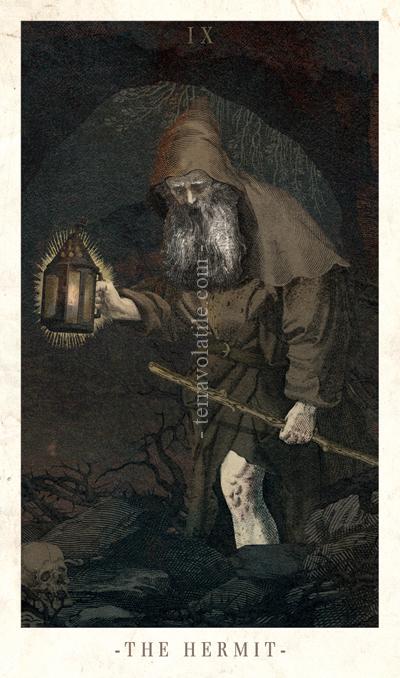
Symbology
The Hermit portrays a man standing by himself in a hostile desert landscape, during the night-time.
The term “Hermit” defines someone who abandoned society and lives a life of solitude. Symbolically speaking, we can refer to the concept of “The Dark Night of the Soul” – a confusing time when we usually feel disoriented, having no sense of direction and lose all hope.
We feel like everything we believe in is thrown into question.
The Hermit forces us to dive into our inner darkness in a journey of self-discovery. The darkest side of this introspective voyage is to find and confront the parts of ourselves we have been repressing such as fears, traumas or desires.
In the same way, the Hermit walks through stones and thorns at night and finds his own underworld, an unknown territory that he gradually explores with a small lantern.
This period represents a transition and self-transformation when we get rid of things that are no longer serving us, in order to walk toward a new stage. Every major transformation has its demons but it is demanding to face them so we can progress in our lives.
However difficult it may be, the Hermit comforts us by giving us the equipment we need for this journey:
– The lamp guides us in the dark, it has the light and wisdom you need to walk forward. It could symbolise our intuition or our inner god guiding us; just like Hecate guided Persephone out of the Underworld with her torches.
– The walking stick aids us to walk, providing stability or support by helping us to keep our balance. The symbolism of these concepts are applied to our darkest journey, mostly as motivational, to prevent us from giving up. The stick also allows us to defend ourselves against any harm – like the wands in Minor Arcana, it represents fire: its active principle grants us strength and determination.
– The cloak, a heavy piece of garment, gives us protection, whether it is the extreme weather or the thorns of our subconscious mind.
When monks or nuns withdraw from the world, they take the habit, make their vows and cover themselves with a cloak. This action symbolises a withdrawal into oneself or into God.
Another common symbolism of the cloak is metamorphosis – the self-transformation required to end this dark chapter successfully.
The Hermit is also represented as an old man with a long white beard that is related to the great wisdom and experience we will achieve in the end. This old man also resembles Saturn/Chronos, the father-time.
In alchemy Saturn is strongly connected to the stage of Nigredo that dissolves matter through the process of putrefaction.
“Putrefaction is so effective that it destroys the old nature and form of the rotting bodies; it transmutes them into a new state of being to give them a totally new fruit. Everything that has life, dies; everything that is dead putrefies and finds a new life.” Antoine-Joseph Pernety, Dictionnaire Mytho-Hermétique (1758), p. 419.
Psychologically speaking, melancholy and depressions are very much associated with that process of putrefaction: “Melancholy means the putrefaction of matter. Philosophers also call this process calcination, incineration and pregnation. It has been given that name to Nigredo, undoubtedly because the dark colour has something upsetting and sad about it, that is why the humour of the human body called melancholy is regarded as a dark and boiled bile, causing gloomy and upsetting auras.” Pernety, Dictionnaire Mytho-Hermétique (1758), p. 318. Therefore, linked to this process of putrefaction is a process of self-awareness and self-knowledge. By feeling the emotions deeply and focusing on them, you reach their core and decompose what has been blocking and stopping you to reach the light. It is painful to confront your inner reality, though vital.
Upright Meaning and Interpretation
Introspection, Self-reflection, Inner-guidance.
The Hermit appears as our mentor who helps us seek answers deep within your mind. Just like him, you need to follow your inner light, the wisdom who guides you through the undiscovered territory of your Self.
This is probably the best moment to detach yourself from society and have a moment alone. Away from the distractions of the outside world, you will find that true knowledge lies within you.
Do not be afraid to face your inner demons, because as soon as you meet them you will probably find some revelations that were unknown to you and they may help you understand the core of the problem.
Through meditation, introspection and self-examination, you may begin to see your goals from a different angle. Looking deeper into your life, you will see your priorities changing as a result, and gaining a different understanding of your spiritual side.
This is a time to focus on yourself and to find your true essence and needs.
Reversed Meaning and Interpretation
Loneliness, Detachment, Anti-social.
The Hermit in reverse tells us that you have been in solitude for a very long time, so it is time to go back to society. To isolate and have a period of self-understanding is beneficial if made in moderation. If it persists for too long, it could have unhealthy effects on you, and people close to you.
The card suggests that you may have apprehensive feelings when it comes to socialising. The Hermit asks you to gradually leave your underground cave.
Alternatively, the reversed Hermit could say that you are avoiding the introspective process, mostly because you are afraid of what you will discover within yourself. You should not fear the person you could be, for it is part of the process to turn you into a greater being – remember how the caterpillar spent time inside the cocoon to become an impressive butterfly.
post scriptum:
“The Dark Night of the Soul” was originally a poem by Spanish mystic and monk Juan de la Cruz (1541-1597), a member of the Carmelite religious order. He was imprisoned because of his efforts to reform and instigate a renewal in the Carmelites, and that is when he wrote that beautiful, powerful poem, about the spiritual journey of the soul towards the heavens and God. Despite its esoteric and poetic message, it became an existential concept in psychiatry and psychology to define a period of despair and demoralization. The previous structures we upheld – identity, relationships, careers, routines or beliefs – lose their value as we submit them to a painful process of awareness. The lone pilgrimage of the Hermit is about this.
